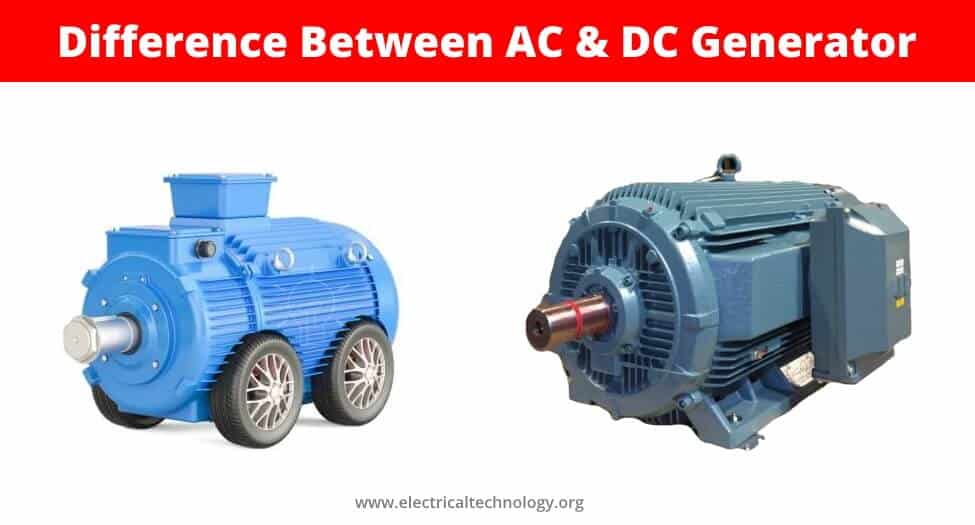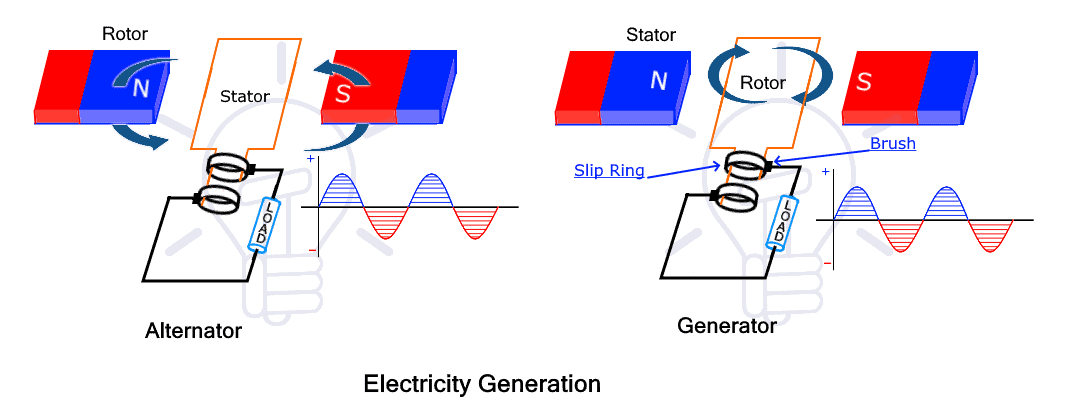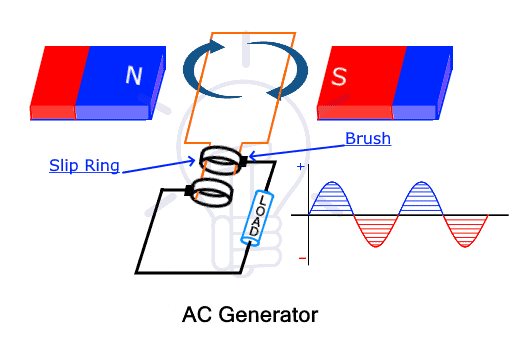Difference Between AC and DC Generator
Main Differences Between AC and DC Generator
The electrical machine is a device that converts mechanical energy into electrical energy & vice versa. The Generator is a type of machine that converts mechanical energy into electrical energy. However, the electrical energy generated can be either in AC or DC form. Therefore, the main point of difference between AC and DC generator is that it generates AC and DC electrical energy respectively. There are few similarities but there are quite a lot of differences between these two generators.
Before going into the list of differences between them, we are going to discuss how the generator generates electricity & how AC & DC is generated.
Electricity Generation
The electricity is generated using Faraday’s law of electromagnetic induction. It states that a current or EMF (Electromotive Force) will be induced in a conductor if it is placed in a changing magnetic field.
The AC or DC generators apply the same principle to generate electric current. However, there are two ways to vary the magnetic field acting on the conductors. Either rotate the magnetic field around a stationary conductor or spin the conductor inside a stationary magnetic field. In both cases, the magnetic field lines acting on the conductor changes & it induces an electric current in the conductor.
The alternator uses the idea of a rotating magnetic field around a stationary magnetic field but we are not discussing it in this article.
The generator uses the later, where the conductor spins inside a stationary magnetic field. The conductor is wounded around an armature in rectangular shape & because it rotates inside a generator, it is known as the Rotor of the generator. The magnetic field surrounding the armature is either a permanent magnet or electromagnetic energized by a separate DC supply which remains stationary. Thus it is known as the Stator of the generator.
Generally, the rotor is the moving or rotating part of an electrical machine & the stator is the stationary part.
Since the armature rotates inside a stationary magnetic field, the direction of the current induced changes through half rotation. Therefore, the current generated inside the armature is always AC.
In order to supply the current from the rotating armature to a stationary circuit, we use a special type of device called slip ring & split ring commutator. It helps in providing AC & DC supply to the circuit. You may refer to the generated electric power transmission and distribution in the previous post.
- Related Post: Difference Between AC and DC Motors
AC Generator
AC generator is a generator that converts mechanical energy into AC electrical energy. It is a type of generator designed to generate alternating current with a frequency of 50 or 60 Hz.
The current induced in the armature is supplied to the circuit using slip rings. The slip rings are two separate conducting rings connected with each terminal of the armature. These rings supply current the circuit through a sliding contact called brushes. The rings always rotate with the armature while the brushes remain stationary.
Since the slip rings are continuous rings it provides the alternating current generated inside the armature. And because the brushes continuously slide across it, there is no issue of short circuit or sparks between them. Therefore, the life expectancy of the brushes in the AC generator is more than the DC generator.
The alternator is another type of generator that only generates AC electrical energy. It has a fixed armature & rotating magnetic field. Since the current is generated in a stationary part, it is more simple & easier to supply it to the stationary circuit. The brushes do not wear out in such cases.
- Related Post: Difference between AC Drives and DC Drives
DC Generator
It is also a type of generator that converts mechanical energy into DC electrical energy. It is also called a dynamo. It generates pulsating Direct current that does not change its direction.
The induced current inside the rotating armature conductors is alternating in nature & it is converted into DC using a split-ring commutator. The commutator supplies the current from the rotating armature to the stationary circuit while maintaining the direction of the supplied current.
The split ring is a ring-shaped conductor split in half so that there are two gaps between the rings. Each half side of the same ring is connected to the separate terminal of the armature conductor & two stationary brush slides across it. The brushes supply current to the circuit.
Since the current induced in the armature is AC, each half rotation changes the current direction in each half of the ring. Therefore, the output current supplied through the stationary brushes remains in one direction.
The Split-ring commutator has a gap between its rings that causes the brushes to touch both halves at the same time & cause short circuits & sparks between them. This wears out the brushes quickly & reduces the performance of the generator.
- Related Post: Difference Between a Transformer and an Induction Motor
Key Differences between AC & DC Generator
| AC Generator | DC Generator |
| It is a mechanical device that converts mechanical energy into AC electrical energy. | It is a mechanical device that converts mechanical energy into DC electrical energy. |
| It is also called alternator or AC generator depending on their construction. | It is also called Dynamo. |
| The current is induced in either the rotor (of AC generator) or the stator (of Alternator) depending on its construction. | The current is induced in the rotor. |
| It generates an alternating current that reverses direction periodically. | It generates a direct current that remains in only one direction. |
| There are no commutators in AC generator. | It has commutators to supply unidirectional current. |
| It uses a slip ring to transfer the induced current smoothly to the circuit. | It uses split rings to transfer the induced current to the circuit & also convert the induce AC into pulsating DC. |
| The generated output voltage amplitude is relatively higher. | The output voltage amplitude is relatively lower. |
| There are low energy losses in the slip rings of AC generator. | There are higher energy losses in the split rings of the DC generators due to sparks. |
| There is no limitation of the voltage generated by the AC generator. | The commutator can be damaged by increasing the voltage due to sparks between them. So DC generators have a voltage limit. |
| The smooth operation of the slip ring increases the brushes life-time. | The split ring wears out the brushes due to sparks between them. it requires periodic replacement. |
| There is no issue of short circuit between the rings. | The brushes sliding across the split ring may cause a short circuit between them. |
| It does not need frequent maintenance & is more reliable. | They are not very reliable & require frequent maintenance. |
| It has relatively higher efficiency due to smooth operation of slip ring than DC generator. | It has relatively lower efficiency due to the inefficient operation of the split ring. |
| It has a simple design. | It has a complex design. |
| The overall cost is low in the long run. Although the initial cost is higher than the DC generator. | The overall cost is expensive due to costly maintenance, but the initial cost is lower than the AC generator. |
| The frequency of the generated output depends on the rotational speed of the armature. | There is no frequency so the rotational speed does not affect it. |
| The generated AC output can be easily converted into low & high voltages for long-distance transmission. | The generated DC output is not efficient for transmission because it needs a costly converter with multiple losses. |
| They are used for supplying power to appliances in office & homes such as lights, fans, mixers, washing machines etc. | They are generally used for powering large DC motors such as in subways systems & charging backup batteries. |
The conclusion of this comparison between AC and DC generators is that AC generators are more durable, reliable & have a simple design as compared to a DC generator. However, DC has no frequency thus the prime mover’s speed does not affect it but it does require frequent maintenance which increases its overall cost.
Related Posts:
- DC Machine – Construction, Working, Types and Applications
- Speed Control of DC Motor – Voltage, Rheostatic & Flux Control Methods
- Difference Between Single Phase & Three Phase Induction Motor
- Emergency Generator Set – Construction, Installation, Maintenance & Wiring
- How to Connect a Portable Generator to the Home Supply – 4 Methods
- EMF Equation of an Alternator and AC Generator
- Why Generator & Alternator rated in kVA. Not in kW?
- Alternator / Generator MCQs with Explanatory Answers
- Generator and Alternator Symbols











Sir ac Alternator dynamo Generetor
3.5kva to 5kva 1piece
Price 5000-9500 Rupees
Tak